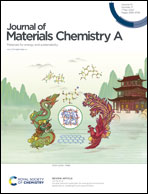Electrostatic force-driven lattice water bridging to stabilize a partially charged indium MOF for efficient separation of C2H2/CO2 mixtures†
Abstract
Highly stable metal–organic frameworks (MOFs) with accessible sites have gradually been valued because of their excellent performance. Here, we proposed a steric hindrance effect to construct a partially charged MOF with electrostatic forces for efficient C2H2/CO2 separation. Two MOFs, [Me2NH2]·[In(BDTA)] 5.5DMF·4H2O (FJU-117, BDTA is [4,4′,4′′,4′′′-([1,1′-biphenyl]-4,4′-diylbis(azanetriyl)) tetrabenzoic acid]) and [In(4Me-BDTA)·0.5H2O]·6DMF·2H2O (FJU-118) were synthesized using a similar procedure except that BDTA in FJU-117 was replaced with 4Me-BDTA in FJU-118. The four methyl groups in 4Me-BDTA in FJU-118 obviously restrict the rotation of the two C–N bonds of ligands. The steric hindrance effect of the 4Me-BDTA results in 7-coordinated In3+ ions in FJU-118, compared to 8-coordinated ones in FJU-117. Accessible sites in FJU-118 with partially remaining charge can provide electrostatic force to anchor lattice water. Electrostatic force-driven lattice water bridging stabilizes the FJU-118 framework. The activated sample FJU-118a exhibits the third highest Brunauer–Emmett–Teller (BET)/Langmuir surface area (1860/2106 m2 g−1) among the reported indium MOFs. The absorption capacities for C2H2 and CO2 at 296/273 K are 88.6/155.1 cm3 g−1 and 35.6/66.9 cm3 g−1, respectively. The single crystal results show that the partially remaining charge on indium sites has an electrostatic force on the –C![[triple bond, length as m-dash]](https://www.rsc.org/images/entities/char_e002.gif) C– bond of C2H2 molecules for the selective separation of C2H2/CO2 mixtures.
C– bond of C2H2 molecules for the selective separation of C2H2/CO2 mixtures.



 Please wait while we load your content...
Please wait while we load your content...